
Moda Center, formerly known as the Rose Garden, is the primary indoor sports arena in Portland, Oregon, United States. It is used for basketball, ice hockey, rodeos, circuses, conventions, ice shows, concerts, and dramatic productions. The arena has a capacity of 19,393 spectators when configured for basketball. It is equipped with state-of-the-art acoustics and other amenities.

Mutual Street Arena, initially called Arena Gardens or just the Arena, was an ice hockey arena and sports and entertainment venue in Toronto, Ontario, Canada. From 1912 until 1931, with the opening of Maple Leaf Gardens, it was the premier site of ice hockey in Toronto, being home to teams from the National Hockey Association (NHA), the National Hockey League (NHL), the Ontario Hockey Association (OHA) and the International Hockey League (IHL). It was the first home of the Toronto Maple Leafs, who played at the arena under various names for their first 13½ seasons. The Arena Gardens was the third rink in Canada to feature a mechanically frozen or 'artificial' ice surface, and for eleven years was the only such facility in eastern Canada. In 1923, it was the site of the first radio broadcast of an ice hockey game, the first radio broadcast of an NHL game, and the first broadcast of an ice hockey game by long-time broadcaster Foster Hewitt.

The Veterans Memorial Coliseum is an indoor arena located in the oldest part of the Rose Quarter area in Portland, Oregon. The arena is the home of the Portland Winterhawks, a major junior ice hockey team, and was the original home of the Portland Trail Blazers of the National Basketball Association. It has been included on the National Register of Historic Places in recognition of its architectural significance.

Gill Coliseum is a multi-purpose indoor arena in the northwest United States, located on the campus of Oregon State University in Corvallis, Oregon. Opened in December 1949, the arena currently lists a seating capacity of 9,301 and is home to the Oregon State Beavers' basketball, wrestling, volleyball, and gymnastics teams. It is named after Amory T. "Slats" Gill, the Beavers' basketball coach for 36 seasons, who compiled a 599–392 (.604) record.
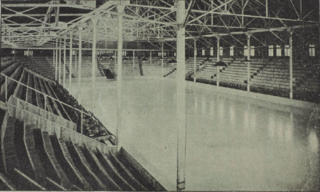
The Montreal Arena, also known as Westmount Arena, was an indoor arena located in Westmount, Quebec, Canada on the corner of St. Catherine Street and Wood Avenue. It was likely one of the first arenas designed expressly for hockey, opening in 1898. It was the primary site of amateur and professional ice hockey in Montreal until 1918.

Clackamas Town Center is a shopping mall established in 1981 in the Portland, Oregon, metropolitan area, located on unincorporated land in the Clackamas area of Clackamas County, in the U.S. state of Oregon. It is managed and co-owned by Brookfield Properties and is currently anchored by JCPenney, Dick's Sporting Goods, Macy's and a separate Macy's Home/Backstage store. It also includes a 20-screen Century movie theater.

Lloyd Center is a shopping mall in the Lloyd District of Portland, Oregon, United States, just northeast of downtown. It is owned by the Urban Renaissance Group and KKR Real Estate Finance Trust Inc. The mall features three floors of shopping, with the third level serving mostly as professional office spaces, a food court, and U.S. Education Corporation's Carrington College. Lloyd Center also includes the Lloyd Center Ice Skating Rink, which has become the main draw for the mall. There are currently no anchors in the mall. There are vacant anchor spaces left by Macy's, Marshalls, Nordstrom, and Sears. Junior anchors include Barnes & Noble and Ross Dress for Less.

The Duquesne Gardens was the main sports arena located in Pittsburgh, Pennsylvania, during the first half of the 20th century. Built in 1890, the building originally served as a trolley barn, before becoming a multi-purpose arena. The Gardens opened three years after a fire destroyed the city's prior sports arena, the Schenley Park Casino, in 1896. Over the years, the Gardens was the home arena of several of Pittsburgh's historic sports teams, such as ice hockey's Pittsburgh Pirates and Pittsburgh Hornets. The Western Pennsylvania Hockey League, which was the first ice hockey league to openly hire and trade players, played all of its games at the Gardens. The arena was also the first hockey rink to ever use glass above the dasher boards. Developed locally by the Pittsburgh Plate Glass Company, Herculite glass was first tested in Pittsburgh. Most rinks were using wire mesh before the shatterproof glass was invented. Finally, the Pittsburgh Ironmen, a charter member of the Basketball Association of America, played at the Gardens from 1946 to 1947.
Dey's Arena, also known as Dey Brothers Rink, Dey's Skating Rink and The Arena, were a series of ice rinks and arenas located in Ottawa, Ontario, that hold importance in the early development of the organized sport of ice hockey in Canada. It was the home arena of the Ottawa Hockey Club, variously known as the Generals, the Silver Seven and the Senators from the 1890s until 1923, although it is known that games were also played at the Rideau Skating Rink in the 1890s and the Aberdeen Pavilion in 1904. The rink and arenas were built by two generations of the Dey family, who were prominent in Ottawa at the time, with a thriving boat works business serving the lumber business. The Dey family also played hockey.
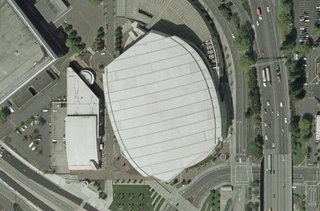
The Rose Quarter is a 30-acre (12-hectare) sports and entertainment district located in Portland's Lloyd District on the east bank of the Willamette River, just east of downtown. The Rose Quarter is bounded on the west by NE Interstate Avenue, on the north by NE Broadway and NE Weidler Streets, on the east by Interstate 5, and on the south by NE Holladay Street. The site contains two multipurpose arenas, the Moda Center and the Memorial Coliseum. Nearby landmarks include the Steel and Broadway bridges, the Oregon Convention Center, and the Eastbank Esplanade.

Quebec Skating Rink was the name of several ice rinks in Quebec City, Quebec. The first was built in 1851, and was the world's first covered skating rink, and was located near the St. Lawrence River. The second rink, built in 1864, was situated on the Grande-Allée, as were the third and fourth rinks. The rinks were developed initially for ice skating, but the developing sport of ice hockey led to the inauguration of the Quebec Hockey Club in the 1880s, which used the rink as their home rink. The hockey club moved to the new, larger Quebec Arena in 1913.

The St. Nicholas Rink, also called the St. Nicholas Arena, was an indoor ice rink, and later a boxing arena in New York City from 1896 until 1962. The rink was one of the earliest indoor ice rinks made of mechanically frozen ice in North America, enabling a longer season for skating sports. It was demolished in the 1980s.
The Portland Open Invitational was a professional golf tournament in the northwest United States on the PGA Tour, played in Portland, Oregon. Established by Robert A. Hudson with a $10,000 purse in 1944, it was played from 1944 to 1948 and again from 1959 to 1966. The event was hosted eight times at the Portland Golf Club, and four times at the Columbia Edgewater Country Club. First played as the Portland Open, the revived 1959 event played as the Portland Centennial Open Invitational, in honor of Oregon's centennial of statehood.

Pioneer Courthouse Square, also known as Portland's living room, is a public space occupying a full 40,000-square-foot (3,700 m2) city block in the center of downtown Portland, Oregon, United States. Opened in 1984, the square is bounded by Southwest Morrison Street on the north, Southwest 6th Avenue on the east, Southwest Yamhill Street on the south, and Southwest Broadway on the west.
The Portland Pilots men's basketball team represents the University of Portland, located in Portland, Oregon, United States, in NCAA Division I basketball competition. They have played their home games at the Chiles Center since 1984, and are members of the West Coast Conference.
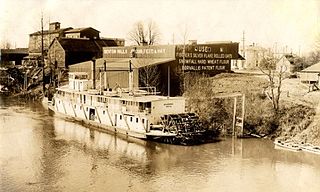
Grahamona was a sternwheel steamboat built in 1912 for the Oregon City Transportation Company, commonly known as the Yellow Stack Line. Grahamona was specially designed to serve on the shallow waters of the upper Willamette River. It was one of the largest steamboats ever to operate on the upper Willamette. In 1920, Grahamona was sold and the name was changed to Northwestern. In 1939, the vessel was sold again, and transferred to Alaska for service on the Kuskokwim River.

La Center was a small stern-wheel steamboat that operated from 1912 to 1931, mostly on the Lewis and Lake rivers in southwest Washington, on a route to and from Portland, Oregon along the lower Columbia and lower Willamette rivers.
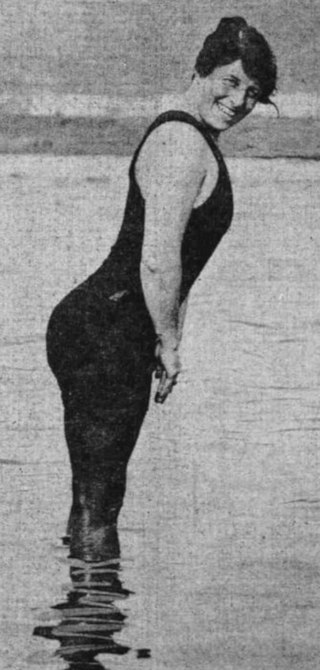
Constance Cycil Meyer was an English American competitive diver who was the Amateur Athletic Union (AAU) women's champion in 1915 and 1917. She was twice runner-up for the AAU diving title; first in 1916 to Aileen Allen and again in 1918 to Thelma Payne. Meyer lived in Portland, Oregon and was a member of the Multnomah Athletic Club under instructor Jack Cody. She also competed in bowling, golf, ice hockey, swimming, tennis and water polo.
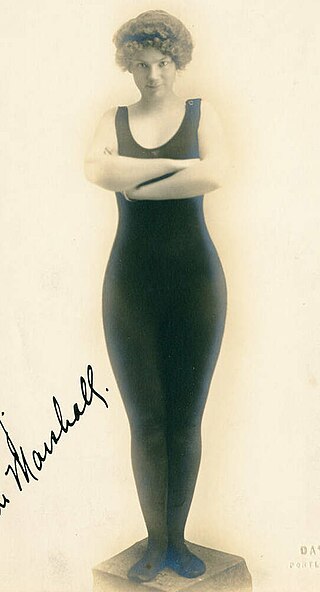
Vivian Augustus Marshall was an American diver, vaudeville performer and film actress. Born in California, Marshall's family moved to Oregon during her youth and she gained notoriety for her aquatic skills while a member of the Multnomah Athletic Club in Portland and later performed public stunt dives from heights of 70 feet and above. She also performed a signature stunt called the "fire dive", in which she would douse her baiting suit in wood alcohol, light it with a match and perform a high dive into the water to extinguish the flames. Marshall worked for vaudeville producer Alexander Pantages and acted in motion pictures in Los Angeles, California. She was married to actor Otto Fries and they had two children, Sherwood Marshall and Ottilie Vivian.


















